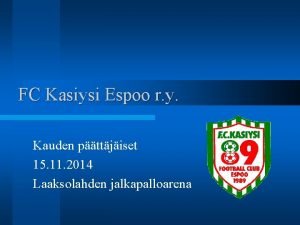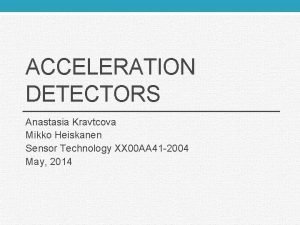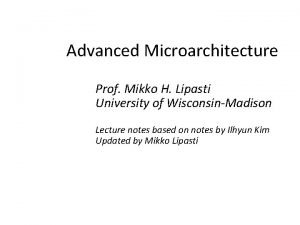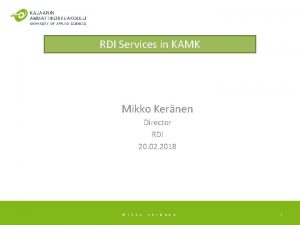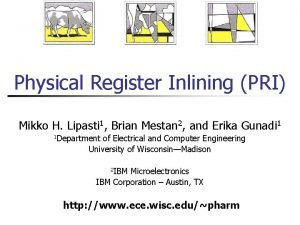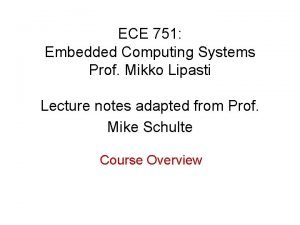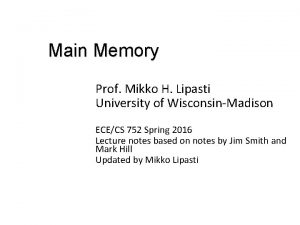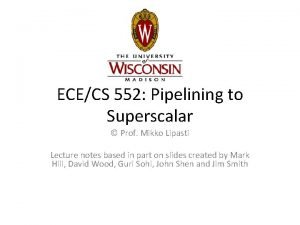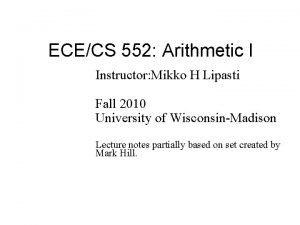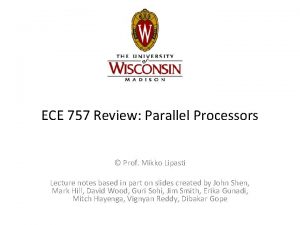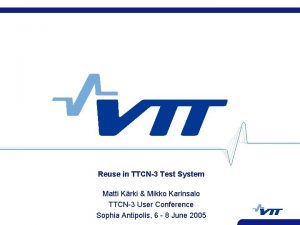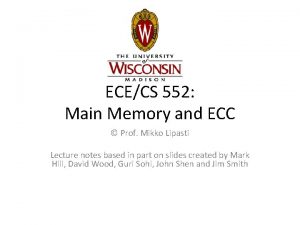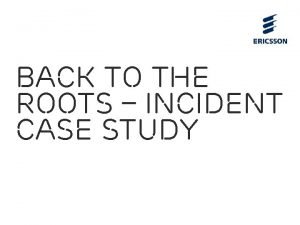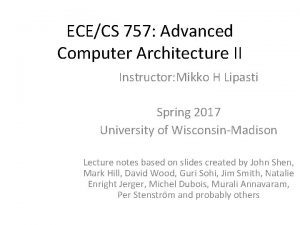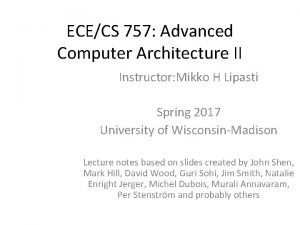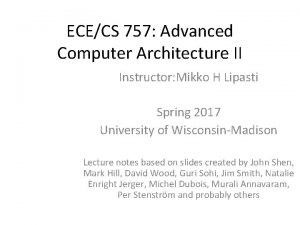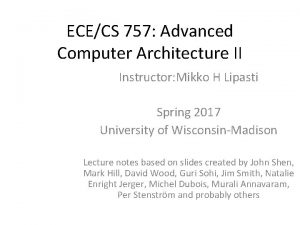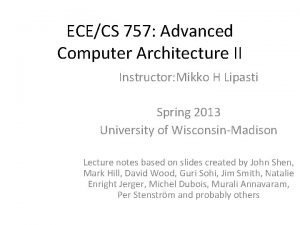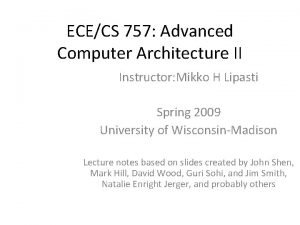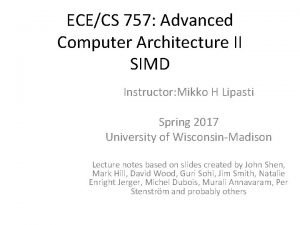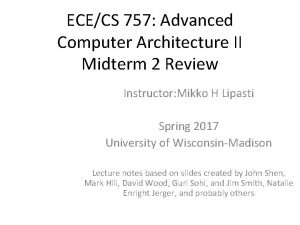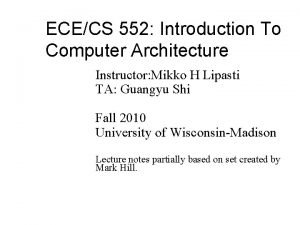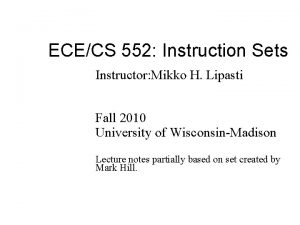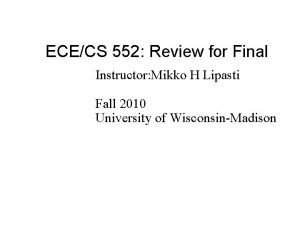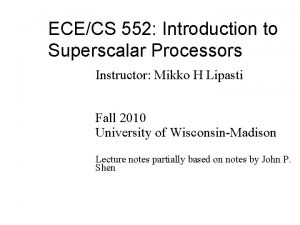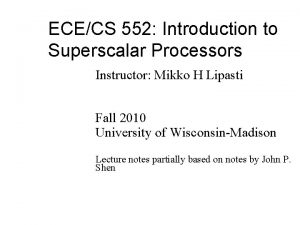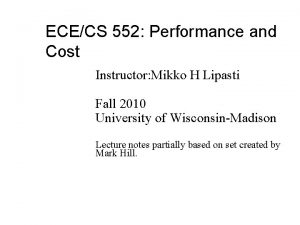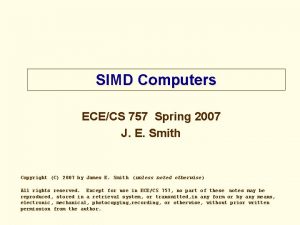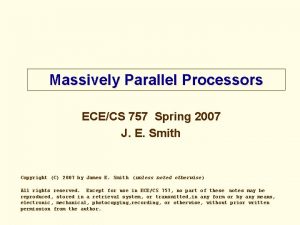ECECS 757 Advanced Computer Architecture II Instructor Mikko













![Minimal Coherence Protocol FSM [Source: Patterson/Hennessy, Comp. Org. & Design] © 2005 Mikko Lipasti Minimal Coherence Protocol FSM [Source: Patterson/Hennessy, Comp. Org. & Design] © 2005 Mikko Lipasti](https://slidetodoc.com/presentation_image/5d824435f86e482dc2da3e143ccc6fe4/image-14.jpg)
















![Update vs Invalidate • [Weber & Gupta, ASPLOS 3] – Consider sharing patterns • Update vs Invalidate • [Weber & Gupta, ASPLOS 3] – Consider sharing patterns •](https://slidetodoc.com/presentation_image/5d824435f86e482dc2da3e143ccc6fe4/image-31.jpg)


























- Slides: 57

ECE/CS 757: Advanced Computer Architecture II Instructor: Mikko H Lipasti Spring 2009 University of Wisconsin-Madison Lecture notes based on slides created by John Shen, Mark Hill, David Wood, Guri Sohi, and Jim Smith, Natalie Enright Jerger, and probably others

Cache Coherence • • • Coherence States Snoopy bus-based Invalidate Protocols Invalidate protocol optimizations Update Protocols (Dragon/Firefly) Directory protocols Implementation issues 2

Readings • Readings: – Firefly – Archibald – Sweazey/Smith – Laudon/Lenoski: Origin 2000 – Opteron – Gigaplane – Power 5 – Intel 870 3

Cache Coherence Problem Load A Store A<= 1 P 0 A P 1 01 A Load A 0 Memory © 2005 Mikko Lipasti 4

Cache Coherence Problem Load A Store A<= 1 P 0 A P 1 10 A Load A 10 Memory © 2005 Mikko Lipasti 5

Possible Causes of Incoherence • Sharing of writeable data – Cause most commonly considered • Process migration – Can occur even if independent jobs are executing • I/O – Often fixed via O/S cache flushes 02/07 ECE/CS 757; copyright J. E. Smith, 2007 6

Cache Coherence • Informally, with coherent caches: accesses to a memory location appear to occur simultaneously in all copies of the memory location “copies” caches • Cache coherence suggests an absolute time scale -- this is not necessary – What is required is the "appearance" of coherence. . . not absolute coherence – E. g. temporary incoherence between memory and a write-back cache may be OK. 02/07 ECE/CS 757; copyright J. E. Smith, 2007 7

Update vs. Invalidation Protocols • Coherent Shared Memory – All processors see the effects of others’ writes • How/when writes are propagated – Determine by coherence protocol © 2005 Mikko Lipasti 8

Global Coherence States • A memory line can be present (valid) in any of the caches and/or memory • Represent global state with an N+1 element vector – First N components => cache states (valid/invalid) – N+1 st component => memory state (valid/invalid) • Example: Line A: <1, 1, 0, 1> Line B: <1, 0, 0, 0> Line C: <0, 0, 0, 1> Cache 0 line A: V line B: I line C: V Cache 1 line A line B 02/07 Memory line A Cache 2 ECE/CS 757; copyright J. E. Smith, 2007

Local Coherence States • Individual caches can maintain a summary of the state of memory lines, from a “local” perspective – Reduces storage for maintaining state – May have only partial information • Invalid (I): <0, X, X, X. . X> -- local cache does not have a valid copy; (cache miss) – Don’t confuse invalid state with empty frame • Shared (S): <1, X, X, X, …, 1> -- local cache has a valid copy, main memory has a valid copy, other caches ? ? • Modified(M): <1, 0, 0, . . 0, … 0> -- local cache has only valid copy. • Exclusive(E): <1, 0, 0, . . 0, … 1> -- local cache has a valid copy, no other caches do, main memory has a valid copy. • Owned(O): <1, X, X, X, …. X> -- local cache has a valid copy, all other caches and memory may have a valid copy. – Only one cache can be in O state – <1, X, … 0> is included in O, but not included in any of the others. 02/07 ECE/CS 757; copyright J. E. Smith, 2007

Example Memory line A: V line B: I line C: V Cache 0 line A line B 02/07 Cache 1 line A Cache 2 ECE/CS 757; copyright J. E. Smith, 2007 11

Snoopy Cache Coherence • All requests broadcast on bus • All processors and memory snoop and respond • Cache blocks writeable at one processor or readonly at several – Single-writer protocol • Snoops that hit dirty lines? – Flush modified data out of cache – Either write back to memory, then satisfy remote miss from memory, or – Provide dirty data directly to requestor – Big problem in MP systems • Dirty/coherence/sharing misses © 2005 Mikko Lipasti 12

Bus-Based Protocols • Protocol consists of states and actions (state transitions) • Actions can be invoked from processor or bus 02/07 ECE/CS 757; copyright J. E. Smith, 2007
![Minimal Coherence Protocol FSM Source PattersonHennessy Comp Org Design 2005 Mikko Lipasti Minimal Coherence Protocol FSM [Source: Patterson/Hennessy, Comp. Org. & Design] © 2005 Mikko Lipasti](https://slidetodoc.com/presentation_image/5d824435f86e482dc2da3e143ccc6fe4/image-14.jpg)
Minimal Coherence Protocol FSM [Source: Patterson/Hennessy, Comp. Org. & Design] © 2005 Mikko Lipasti 14

MSI Protocol Action and Next State Current State 02/07 Eviction Cache Read Processor Write I Cache Read Acquire Copy → S Cache Read&M Acquire Copy → M No Action → I S No Action → S Cache Upgrade → M No Action → I No Action → S Invalidate Frame → I M No Action → M Cache Write back → I Memory inhibit; Supply data; → S Invalidate Frame; Memory inhibit; Supply data; → I ECE/CS 757; copyright J. E. Smith, 2007 Cache Read&M Cache Upgrade

MSI Example Thread Event Bus Action Data From Global State 0. Initially: 1. T 0 read→ CR Memory 2. T 0 write→ CU Local States: C 0 C 1 C 2 <0, 0, 0, 1> I I I <1, 0, 0, 1> S I I <1, 0, 0, 0> M I I 3. T 2 read→ CR C 0 <1, 0, 1, 1> S I S 4. T 1 write→ CRM Memory <0, 1, 0, 0> I M I • If line is in no cache – Read, modify, Write requires 2 bus transactions – Optimization: add Exclusive state 02/07 ECE/CS 757; copyright J. E. Smith, 2007

Invalidate Protocol Optimizations • Observation: data can be read shared – Add S (shared) state to protocol: MSI • State transitions: – – Local read: I->S, fetch shared Local write: I->M, fetch modified; S->M, invalidate other copies Remote read: M->S, supply data Remote write: M->I, supply data; S->I, invalidate local copy • Observation: data can be write-private (e. g. stack frame) – Avoid invalidate messages in that case – Add E (exclusive) state to protocol: MESI • State transitions: – Local read: I->E if only copy, I->S if other copies exist – Local write: E->M silently, S->M, invalidate other copies © 2005 Mikko Lipasti 17

MESI Protocol • Variation used in Pentium Pro/2/3 – (cache to cache transfer) • 4 -State Protocol – Modified: <1, 0, 0… 0> – Exclusive: <1, 0, 0, …, 1> – Shared: <1, X, X, …, 1> – Invalid: <0, X, X, …X> • Bus/Processor Actions – Same as MSI • Adds shared signal to indicate if other caches have a copy 02/07 ECE/CS 757; copyright J. E. Smith, 2007 18

MESI Protocol Action and Next State Current State 02/07 Processor Read Processor Write Eviction Cache Read&M Cache Upgrade I Cache Read If no sharers: → E If sharers: → S Cache Read&M → M No Action → I S No Action → S Cache Upgrade → M No Action → I Respond Shared: → S No Action → I E No Action → I Respond Shared; → S No Action → I M No Action → M Cache Write-back → I Respond dirty; Write back data; → S Respond dirty; Write back data; → I No Action → M ECE/CS 757; copyright J. E. Smith, 2007

MESI Example • Optimization – cache-to-cache transfer for shared data (but only one sharer can respond) • If modified in some cache and another reads then writeback to memory (w/ snarf) – Optimization: add Owned state (and perform cache-to-cache transfer) Thread Event Bus Action Data From Global State Local States: C 0 C 1 C 2 0. Initially: 1. T 0 read→ CR 2. T 0 write→ none 02/07 <0, 0, 0, 1> I I I Memory <1, 0, 0, 1> E I I <1, 0, 0, 0> M I I ECE/CS 757; copyright J. E. Smith, 2007

MOESI Optimization • Observation: shared ownership complicates/delays sourcing data Owner is responsible for sourcing data to any requestor Add O (owner) state to protocol: MOSI/MOESI Last requestor becomes the owner Ownership can be on per-node basis in hierarchically structured system – Avoid writeback (to memory) of dirty data – Also called shared-dirty state, since memory is stale – – © 2005 Mikko Lipasti 21

MOESI Protocol • Used in AMD Opteron • 5 -State Protocol – – – Modified: <1, 0, 0… 0> Exclusive: <1, 0, 0, …, 1> Shared: <1, X, X, …, X> Invalid: <0, X, X, …X> Owned: <1, X, X> ; only one owner • Owner can supply data, so memory does not have to – Avoids lengthy memory access 02/07 ECE/CS 757; copyright J. E. Smith, 2007 22

MOESI Protocol Action and Next State Current State 02/07 Processor Read Processor Write Eviction I Cache Read If no sharers: → E If sharers: → S Cache Read&M → M S No Action → S Cache Upgrade → M E No Action → M O No Action → O M No Action → M Cache Read&M Cache Upgrade No Action → I Respond shared; → S No Action → I Respond shared; Supply data; → S Respond shared; Supply data; → I Cache Upgrade → M Cache Write -back → I Respond shared; Supply data; → O Respond shared; Supply data; → I No Action → M Cache Write -back → I Respond shared; Supply data; → O Respond shared; Supply data; → I ECE/CS 757; copyright J. E. Smith, 2007

MOESI Example Thread Event Bus Action Data From Global State 0. Initially: 1. T 0 read→ CR Memory 2. T 0 write→ none local states C 0 C 1 C 2 <0, 0, 0, 1> I I I <1, 0, 0, 1> E I I <1, 0, 0, 0> M I I 3. T 2 read→ CR C 0 <1, 0, 1, 0> O I S 4. T 1 write→ CRM C 0 <0, 1, 0, 0> I M I 02/07 ECE/CS 757; copyright J. E. Smith, 2007

Update Protocols • Basic idea: – All writes (updates) are made visible to all caches: • (address, value) tuples sent “everywhere” • Similar to write-through protocol for uniprocessor caches – Obviously not scalable beyond a few processors – No one actually builds machines this way • Simple optimization – Send updates to memory/directory – Directory propagates updates to all known copies: less bandwidth • Further optimizations: combine & delay – Write-combining of adjacent updates (if consistency model allows) – Send write-combined data – Delay sending write-combined data until requested • Logical end result – Writes are combined into larger units, updates are delayed until needed – Effectively the same as invalidate protocol © 2005 Mikko Lipasti 25

Update Protocol: Dragon • Dragon (developed at Xerox PARC) • 5 -State Protocol – Invalid: <0, X, X, …X> • Some say no invalid state – due to confusion regarding empty frame – – – versus invalid line state Exclusive: <1, 0, 0, …, 1> Shared-Clean (Sc): <1, X, X, …X> memory may not be up-to-date Shared-Modified (Sm): <1, X, X, X… 0> memory not up-to-date; only one copy in Sm Modified: <1, 0, 0, … 0> – • Includes Cache Update action • Includes Cache Writeback action • Bus includes Shared flag – Appears to also require memory inhibit signal – Distinguish shared case where cache (not memory) supplies data 02/07 ECE/CS 757; copyright J. E. Smith, 2007 26

Dragon State Diagram Action and Next State Current State 02/07 Processor Read Processor Write Eviction Cache Read If no sharers: → E If sharers: → Sc Cache Read If no sharers: → M If sharers: Cache Update → Sm → I Sc No Action → Sc Cache Update If no sharers: →M If sharers: → Sm No Action → I E No Action → E No Action → M No Action → I Respond shared; Supply data → Sc Sm No Action → Sm Cache Update If no sharers: →M If sharers: → Sm Cache Write-back → I Respond shared; Supply data; → Sm M No Action → M Cache Write-back → I Respond shared; Supply data; → Sm Respond Shared; → Sc ECE/CS 757; copyright J. E. Smith, 2007 Cache Update → I Respond shared; Update copy; → Sc

Example Thread Event Bus Action Data From 0. Initially: 1. T 0 read→ CR Memory 2. T 0 write→ none Global State local states C 0 C 1 C 2 <0, 0, 0, 1> I I I <1, 0, 0, 1> E I I <1, 0, 0, 0> M I I 3. T 2 read→ CR C 0 <1, 0, 1, 0> Sm I Sc 4. T 1 write→ CR, CU C 0 <1, 1, 1, 0> Sc Sm Sc 5. T 0 read→ C 0 <1, 1, 1, 0> Sc Sm Sc none (hit) • Appears to require atomic bus cycles CR, CU on write to invalid line 02/07 ECE/CS 757; copyright J. E. Smith, 2007

Update Protocol: Firefly • Develped at DEC by ex-Xerox people • 5 -State Protocol – Similar to Dragon – different state naming based on shared/exclusive and clean/dirty Invalid: <0, X, X, …X> EC: <1, 0, 0, …, 1> SC: <1, X, X, …X> memory may not be up-to-date EM: <1, 0, 0, … 0> SM: <1, X, X, X… 0> memory not up-to-date; only one copy in Sm – – – • Performs write-through updates (different from Dragon) 02/07 ECE/CS 757; copyright J. E. Smith, 2007 29

Firefly State Diagram Action and Next State Current State 02/07 Processor Read Processor Write Eviction Cache Read If no sharers: → Ec If sharers: → Sc Cache Read If no sharers: → Em If sharers: Cache Update → Sm Sc No Action → Sc Cache Read&M If no sharers: →Ec If sharers: → Sc No Action → I Ec No Action → Ec No Action → Em No Action → I Respond shared; → Sc Respond Shared → Sc Sm No Action → Sm Cache Read&M If no sharers: →Ec If sharers: → Sc Cache Write-back → I Respond shared; Supply data; → Sm Respond shared; Supply data; → Sc Em No Action → Em Cache Write-back → I Respond shared; Supply data; → Sm Respond shared; Supply data; → Sc ECE/CS 757; copyright J. E. Smith, 2007 No Action → I Cache Read&M Respond Shared; → Sc No Action → I Respond Shared → Sc
![Update vs Invalidate Weber Gupta ASPLOS 3 Consider sharing patterns Update vs Invalidate • [Weber & Gupta, ASPLOS 3] – Consider sharing patterns •](https://slidetodoc.com/presentation_image/5d824435f86e482dc2da3e143ccc6fe4/image-31.jpg)
Update vs Invalidate • [Weber & Gupta, ASPLOS 3] – Consider sharing patterns • No Sharing – Independent threads – Coherence due to thread migration – Update protocol performs many wasteful updates • Read-Only – No significant coherence issues; most protocols work well • Migratory Objects – Manipulated by one processor at a time – Often protected by a lock – Usually a write causes only a single invalidation – E state useful for Read-modify-Write patterns – Update protocol could proliferate copies 02/07 ECE/CS 757; copyright J. E. Smith, 2007 31

Update vs Invalidate, contd. • Synchronization Objects – Locks – Update could reduce spin traffic invalidations – Test&Set w/ invalidate protocol would work well • Many Readers, One Writer – Update protocol may work well, but writes are relatively rare • Many Writers/Readers – Invalidate probably works better – Update will proliferate copies • What is used today? – Invalidate is dominant – CMP may change this assessment • more on-chip bandwidth 02/07 ECE/CS 757; copyright J. E. Smith, 2007 32

Nasty Realities • State diagram is for (ideal) protocol assuming instantaneous and actions • In reality controller implements more complex diagrams – A protocol state transition may be started by controller when bus activity changes local state – Example: an upgrade pending (for bus) when an invalidate for same line arrives 02/07 ECE/CS 757; copyright J. E. Smith, 2007

Partial Implementation State Table Action and Next State Current State Processor Read Processor Write I Request Bus → IR Request Bus → IW S No Action → S E M Bus Grant Bus Response Cache Read&M Cache Upgrade No Action → I Request Bus → SW Respond Shared: → S No Action → I No Action → E No Action → M Respond Shared; → S No Action → I No Action → M Respond dirty; Write back data; → S Respond dirty; Write back data; → I Cache Read → IRR IW Cache Read&M → IWR IRR If no sharers: → E If sharers: → S Load line IWR → M Load line 02/07 Cache Read No Action → I IR SW Cache Upgrade Respond Shared: ECE/CS 757; copyright J. E. Smith, 2007 → M → SW No Action → IW

Further Optimizations • Observation: Shared blocks should only be fetched from memory once – If I find a shared block on chip, forward the block – Problem: multiple shared blocks possible, who forwards? • Everyone? Power/bandwidth wasted – Single forwarder, but who? • Last one to receive block: F state • I->F for requestor, F->S forwarder – What if F block is evicted? • Favor F blocks in replacement? • Don’t allow silent eviction (force some other node to be F) • Fall back on memory copy if can’t find F copy • Very old idea (IBM machines have done this for a long time), but recent Intel patent issued anyway [Hum/Goodman] © 2005 Mikko Lipasti 35

Further Optimizations • Observation: migratory data often “flies by” – – – Add T (transition) state to protocol Tag is still valid, data isn’t Data can be snarfed as it flies by Only works with certain kinds of interconnect networks Replacement policy issues • Many other optimizations are possible – Literature extends 25 years back – Many unpublished (but implemented) techniques as well © 2005 Mikko Lipasti 36

Implementing Cache Coherence • Snooping implementation – – Origins in shared-memory-bus systems All CPUs could observe all other CPUs requests on the bus; hence “snooping” • – Bus Read, Bus Write, Bus Upgrade React appropriately to snooped commands • • Invalidate shared copies Provide up-to-date copies of dirty lines – – • Flush (writeback) to memory, or Direct intervention (modified intervention or dirty miss) Snooping suffers from: – – – Scalability: shared busses not practical Ordering of requests without a shared bus Lots of recent and on-going work on scaling snoop-based systems © 2005 Mikko Lipasti 37

Snooping Cache Coherence • Basic idea: broadcast snoop to all caches to find owner • Not scalable? – Address traffic roughly proportional to square of number of processors – Current implementations scale to 64/128 -way (Sun/IBM) with multiple address-interleaved broadcast networks • Inbound snoop bandwidth: big problem © 2005 Mikko Lipasti 38

Snoop Bandwidth l l Snoop filtering of various kinds is possible Filter snoops at sink: Jetty filter [Moshovos et al. , HPCA 2001] l Filter snoops at source: Multicast snooping [Bilir et al. , ISCA 1999] l Filter snoops at source: Region coherence – Check small “filter cache” that summarizes contents of local cache – Avoid power-hungry lookups in each tag array – Predict likely sharing set, snoop only predicted sharers – Double-check at directory to make sure – Concurrent work: [Cantin/Smith/Lipasti, ISCA 2005; Moshovos, ISCA 2005] – Check larger region of memory on every snoop; remember when no sharers – Snoop only on first reference to region, or when region is shared – Eliminate 60%+ of all snoops © 2005 Mikko Lipasti 39

Snoop Latency l Snoop latency: – – l Must reach all nodes, return and combine responses Probably the bigger scalability issue in the future Topology matters: ring, mesh, torus, hypercube No obvious solutions Parallelism: fundamental advantage of snooping – Broadcast exposes parallelism, enables speculative latency reduction © 2005 Mikko Lipasti 40

Scaleable Cache Coherence • Eschew physical bus but still snoop – Point-to-point tree structure (indirect) or ring – Root of tree or ring provide ordering point – Use some scalable network for data (ordering less important) • Or, use level of indirection through directory – Directory at memory remembers: • Which processor is “single writer” • Which processors are “shared readers” – Level of indirection has a price • Dirty misses require 3 hops instead of two – Snoop: Requestor->Owner – Directory: Requestor->Directory->Owner © 2005 Mikko Lipasti 41

Implementing Cache Coherence • Directory implementation – – – Extra bits stored in memory (directory) record state of line Memory controller maintains coherence based on the current state Other CPUs’ commands are not snooped, instead: • – – • Directory forwards relevant commands Powerful filtering effect: only observe commands that you need to observe Meanwhile, bandwidth at directory scales by adding memory controllers as you increase size of the system • Leads to very scalable designs (100 s to 1000 s of CPUs) Directory shortcomings – – – Indirection through directory has latency penalty If shared line is dirty in other CPU’s cache, directory must forward request, adding latency This can severely impact performance of applications with heavy sharing (e. g. relational databases) © 2005 Mikko Lipasti 42

Directory Protocol Implementation • • Basic idea: Centralized directory keeps track of data location(s) Scalable – Address traffic roughly proportional to number of processors Directory & traffic can be distributed with memory banks (interleaved) Directory cost (SRAM) or latency (DRAM) can be prohibitive – – – Full map (N processors, N bits): cost/scalability Limited map (limits number of sharers) Coarse map (identifies board/node/cluster; must use broadcast) – – – Point to shared copies Fixed number, linked lists (SCI), caches chained together Latency vs. cost vs. scalability – – Presence bits track sharers Vectors track sharers © 2005 Mikko Lipasti 43

Directory Protocol Latency • • Access to non-shared data – Overlap directory read with data read – Best possible latency given NUMA arrangement Access to shared data – Dirty miss, modified intervention – Shared intervention? • • If DRAM directory, no gain If directory cache, possible gain (use F state) – No inherent parallelism – Indirection adds latency – Minimum 3 hops, often 4 hops © 2005 Mikko Lipasti 44

Directory-based Cache Coherence • • An alternative for large, scalable MPs Can be based on any of the protocols discussed thus far –We will use MSI • • Memory Controller becomes an active participant Sharing info held in memory directory –Directory may be distributed • • Use point-to-point messages Network is not totally ordered 02/07 ECE/CS 757; copyright J. E. Smith, 2007

Example: Simple Directory Protocol • Local cache controller states – M, S, I as before • Local directory states – Shared: <1, X, X, … 1>; one or more proc. has copy; memory is up-to-date – Modified: <0, 1, 0, …. , 0> one processor has copy; memory does not have a valid copy – Uncached: <0, 0, … 0, 1> none of the processors has a valid copy • Directory also keeps track of sharers – Can keep global state vector in full – e. g. via a bit vector 02/07 ECE/CS 757; copyright J. E. Smith, 2007 46

Example • • Local cache suffers load miss Line in remote cache in M state – It is the owner • Four messages send over network – Cache read from local controller to home memory controller – Memory read to remote cache controller – Owner data back to memory controller; change state to S – Memory data back to local cache; change state to S 02/07 ECE/CS 757; copyright J. E. Smith, 2007

Cache Controller State Diagram • Intermediate States for clarity Cache Controller Actions and Next States from Processor Side Current State Processor Read Processor Write from Memory Side Eviction Memory Read&M Memory Invalidate Memory Upgrade I Cache Read → I' Cache Read&M → I'' No Action → I S No Action → S Cache Upgrade → S' No Action* → I Invalidate Frame; Cache ACK; → I M No Action → M Cache Write-back → I Owner Data; → S Invalidate Frame; Cache ACK; → I Owner Data; → I I' Fill Cache → S I'' Fill Cache → M S' 02/07 Memory Data ECE/CS 757; copyright J. E. Smith, 2007 No Action → M 48

Memory Controller State Diagram Memory Controller Actions and Next States command from Local Cache Controller Current Directory State U S M Cache Read&M response from Remote Cache Controller Cache Upgrade Memory Data; Add Requestor to Sharers; → S Memory Data; Add Requestor to Sharers; → M Memory Data; Add Requestor to Sharers; → S Memory Invalidate All Sharers; → M' Memory Upgrade All Sharers; → M'' Memory Read from Owner; → S' Memory Read&M; to Owner → M' Data Write-back Cache ACK No Action → I Make Sharers Empty; → U S' M' When all ACKS Memory Data; → M M'' When all ACKS then → M 02/07 Owner Data ECE/CS 757; copyright J. E. Smith, 2007 Memory Data to Requestor; Write memory; Add Requestor to Sharers; → S Memory Data to Requestor; → M 49

Another Example • Local write (miss) to shared line • Requires invalidations and acks 02/07 ECE/CS 757; copyright J. E. Smith, 2007

Example Sequence • Similar to earlier sequences Thread Event Controller Actions Data From 0. Initially: local states: C 0 C 1 C 2 <0, 0, 0, 1> I I I <1, 0, 0, 1> S I I <1, 0, 0, 0> M I I 1. T 0 read→ CR, MD 2. T 0 write→ CU, MU*, MD 3. T 2 read→ CR, MD C 0 <1, 0, 1, 1> S I S 4. T 1 write→ CRM, MI, CA, MD Memory <0, 1, 0, 0> I M I 02/07 Memory global state ECE/CS 757; copyright J. E. Smith, 2007

Variation: Three Hop Protocol • Have owner send data directly to local controller • Owner Acks to Memory Controller in parallel 02/07 ECE/CS 757; copyright J. E. Smith, 2007

Directory Protocol Optimizations • • • Remove dead blocks from cache: – – Eliminate 3 - or 4 -hop latency Dynamic Self-Invalidation [Lebeck/Wood, ISCA 1995] Last touch prediction [Lai/Falsafi, ISCA 2000] Dead block prediction [Lai/Fide/Falsafi, ISCA 2001] – – – Prediction in coherence protocols [Mukherjee/Hill, ISCA 1998] Instruction-based prediction [Kaxiras/Goodman, ISCA 1999] Sharing prediction [Lai/Falsafi, ISCA 1999] – – – Improve latency by snooping, conserve bandwidth with directory Multicast snooping [Bilir et al. , ISCA 1999; Martin et al. , ISCA 2003] Bandwidth-adaptive hybrid [Martin et al. , HPCA 2002] Token Coherence [Martin et al. , ISCA 2003] VCT Multicasting [Enright Jerger thesis 2008] Predict sharers Hybrid snooping/directory protocols © 2005 Mikko Lipasti 53

Protocol Races • Atomic bus – Only stable states in protocol (e. g. M, S, I) – All state transitions are atomic (I->M) – No conflicting requests can interfere since bus is held till transaction completes • Distinguish coherence transaction from data transfer • Data transfer can still occur much later; easier to handle this case • Atomic buses don’t scale – At minimum, separate bus request/response • Large systems have broadly variable delays – Req/resp separated by dozens of cycles – Conflicting requests can and do get issued – Messages may get reordered in the interconnect • How do we resolve them? 54

Resolving Protocol Races • Req/resp decoupling introduces transient states – E. g. I->S is now I->Ito. X->Ito. S_nodata->S • Conflicting requests to blocks in transient states – NAK – ugly; livelock, starvation potential – Keep adding more transient states … • Directory protocol makes this a bit easier – Can order at directory, which has full state info – Even so, messages may get reordered 55

Common Protocol Races • Read strings: P 0 read, P 1 read, P 2 read – Easy, since read is nondestructive – Can rely on F state to reduce DRAM accesses – Forward reads to previous requestor (F) • Write strings: P 0 write, P 1 write, P 2 write – Forward P 1 write req to P 0 (M) – P 0 completes write then forwards M block to P 1 – Build string of writes (write string forwarding) • Read after write (similar to prev. WAW) • Writeback race: P 0 evicts dirty block, P 1 reads – Dirty block is in the network (no copy at P 0 or at dir) – NAK P 1, or force P 0 to keep copy till dir ACKs WB • Many others crop up, esp. with optimizations 56

Summary • • • Coherence States Snoopy bus-based Invalidate Protocols Invalidate protocol optimizations Update Protocols (Dragon/Firefly) Directory protocols Implementation issues 57
 Ececs
Ececs Akta pengurusan strata 2013
Akta pengurusan strata 2013 Nearest ten thousand
Nearest ten thousand 537-317-757
537-317-757 Basic instructor course texas
Basic instructor course texas Tcole advanced instructor course
Tcole advanced instructor course Tcole advanced instructor course
Tcole advanced instructor course Fundamentals of cpu in advanced computer architecture
Fundamentals of cpu in advanced computer architecture Bus design in computer architecture
Bus design in computer architecture Computer architecture vs computer organization
Computer architecture vs computer organization Design of basic computer
Design of basic computer Mikko ranta-huitti
Mikko ranta-huitti Sirpa kesonen
Sirpa kesonen Mikko posti
Mikko posti Mikko häikiö
Mikko häikiö Joannaseppa
Joannaseppa Mikko juusela
Mikko juusela Mikko manka tampereen yliopisto
Mikko manka tampereen yliopisto Mikko heiskanen
Mikko heiskanen Mikko vienonen
Mikko vienonen Mikko sola
Mikko sola Mikko karppinen
Mikko karppinen Mikko lipasti
Mikko lipasti Mikko lappalainen
Mikko lappalainen Mikko keränen kamk
Mikko keränen kamk Mikko mäkelä metropolia
Mikko mäkelä metropolia Mikko ranta njs
Mikko ranta njs Mikko ulander
Mikko ulander Mikko h. lipasti
Mikko h. lipasti Mikko lindeman
Mikko lindeman Mikko lipasti
Mikko lipasti Mikko h. lipasti
Mikko h. lipasti Mikko tiira
Mikko tiira Mikko nieminen
Mikko nieminen Mikko h. lipasti
Mikko h. lipasti Mikko lipasti
Mikko lipasti Mikko bentlin
Mikko bentlin Tietovirtakaavio
Tietovirtakaavio Mikko routala
Mikko routala Mikko h. lipasti
Mikko h. lipasti Mikko lipasti
Mikko lipasti Mikko h. lipasti
Mikko h. lipasti Mikko lipasti
Mikko lipasti System by mikko
System by mikko Mikko lipasti
Mikko lipasti Ked ferno
Ked ferno Mikko lipasti
Mikko lipasti Mikko karikytö
Mikko karikytö Advanced topics in computer science
Advanced topics in computer science Craig reinhart
Craig reinhart Advanced computer forensics
Advanced computer forensics Advanced computer forensics
Advanced computer forensics Tipos de participantes en un grupo
Tipos de participantes en un grupo Tcole instructor course
Tcole instructor course Basic instructor course texas
Basic instructor course texas Basic instructor course #1014
Basic instructor course #1014 Pepperball launcher nomenclature
Pepperball launcher nomenclature Not only the students but also the instructor
Not only the students but also the instructor















